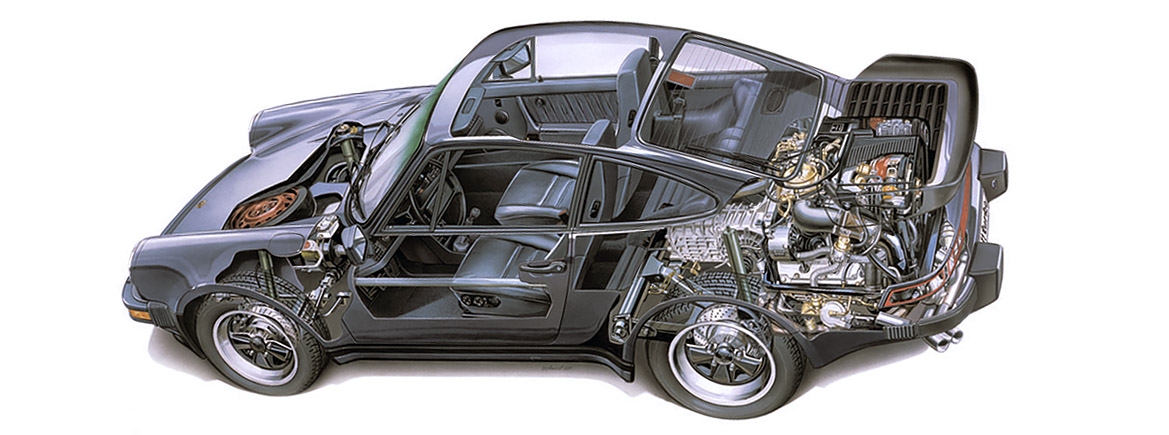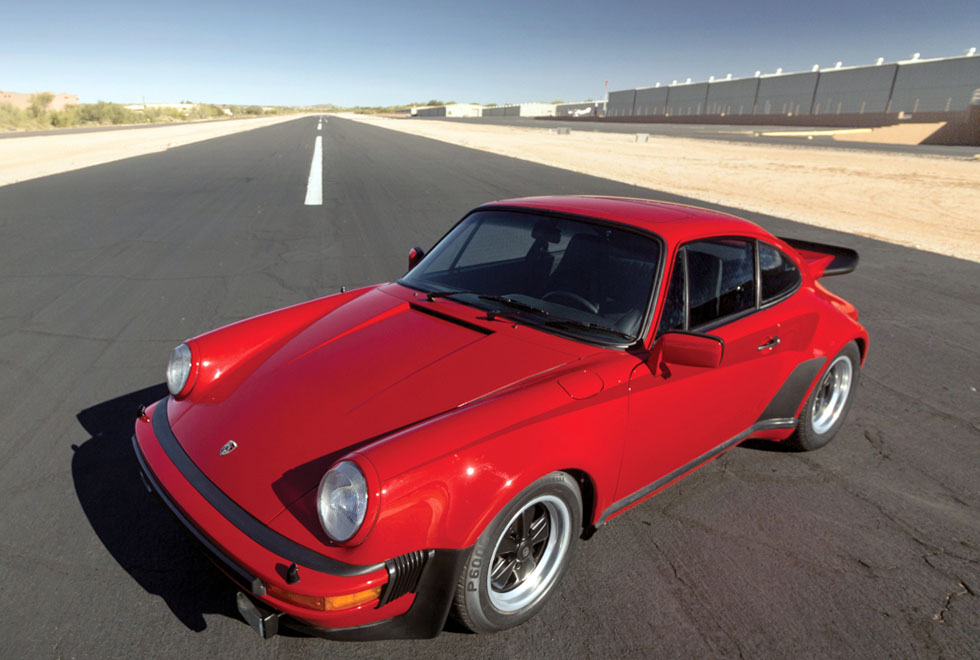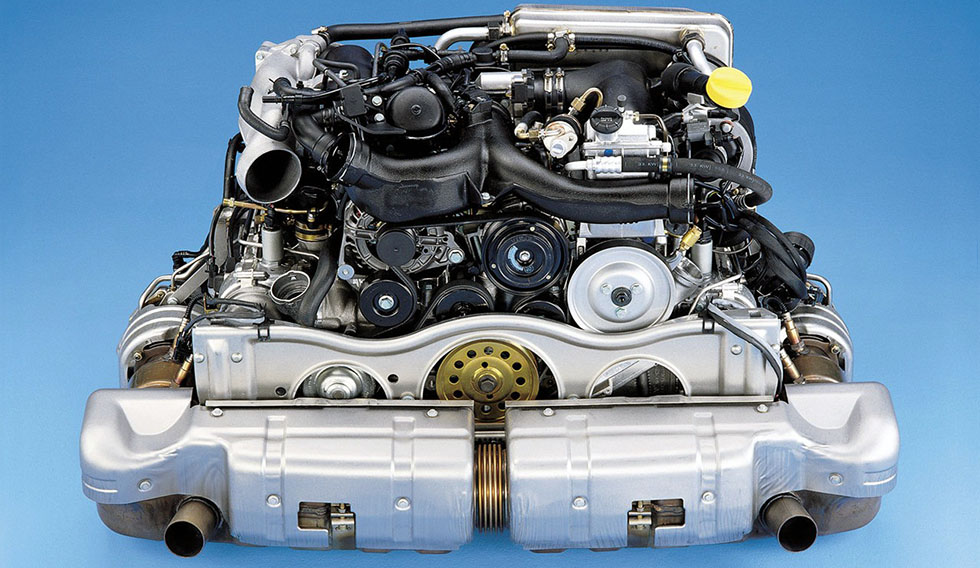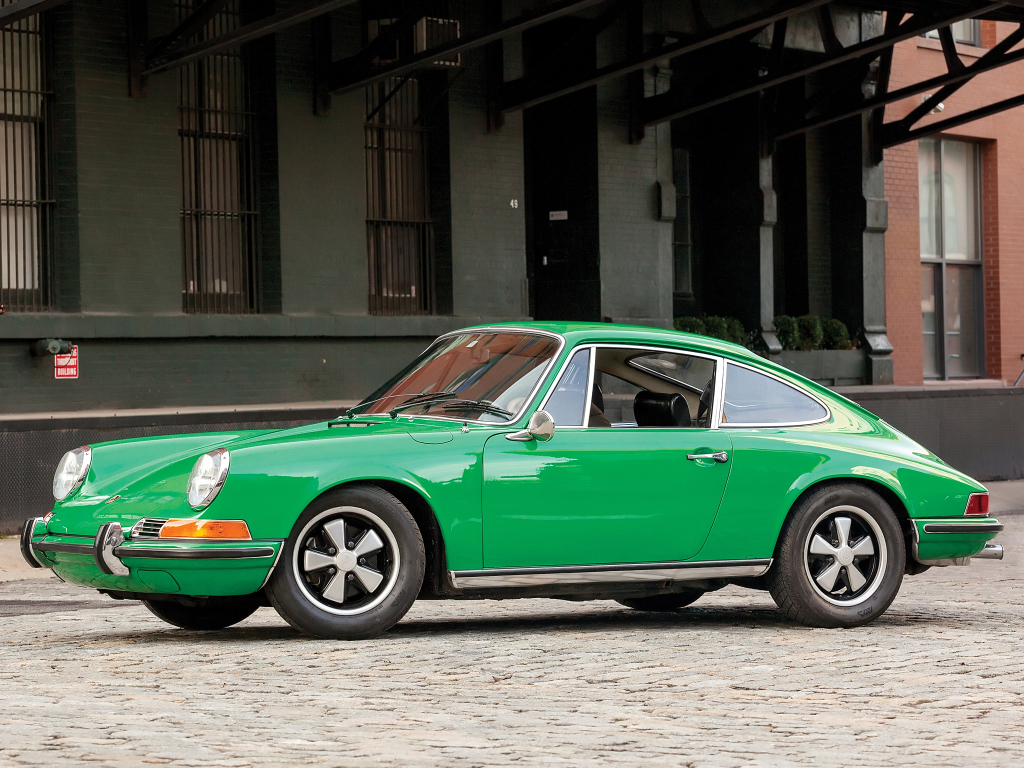
How it works – more than just a Beetle engine with a couple of extra cylinders: we look inside the air-cooled Porsche flat six. It may have been derived from the humble Beetle unit but Porsche’s air-cooled flat six outlived all its other engine designs.
In continuous production from 1964 to 1998, the Porsche flat-six unit as used in the 911 is one of its longest-serving production engines, outliving both the straight-four and V8 units used in the 944 and 928 cars designed to replace the 911. Whilst the flat four in the previous 356 was basically a heavily modified VW type unit – although by the late ‘50s there were very few common parts – the 911 unit was all new but stuck to the Porsche air cooled principles.
By and large the 911 unit is a good one but there were a few issues as you’d expect – but it was often the lowest powered versions that gave the problems.
THE 911 BEGINS
The 911 was shown at the 1963 Frankfurt motor show, badged as the 901. Peugeot claimed the rights to all three-digit numbers for road cars, and so the 901 became the 911 when production began in 1964, with the 356 ceasing production a year later, to be replaced in turn by the 356-engined four-cylinder 912 model. The 911 engine started life a 2.0-litre unit.
Originally, it was going to be a wet sump unit and development engines were coded Type 821 even though it shared the same basic design of a split crankcase, removable finned barrels and OHC cylinder heads with hemi chambers. The even earlier Type 745 unit was a 2.0-litre pushrod unit with a four-bearing crankshaft but this was too big, too heavy and too noisy and Porsche did well to abandon it to concentrate on the 821 and 901 units.
Those overhead cams were chain-driven where the previous Carrera 356 engine had used shaft and bevel gear drive: strong and reliable but noisy. Porsche’s technical director Hans Tomala also gave some thought to having belt-driven cams as used by Glas, but Porsche was a fairly conventional firm inasmuch that they liked to over-engineer things with proven technology.
To make the chain drive as reliable as possible, Porsche used Renolds chains with a hydraulic tensioner per chain. Very high-quality chains were needed because with its light flywheel, the 911 engine could whip up and down through the rev range and thus create very high inertia forces, which is the very reason timing chains can be troublesome on today’s engines.
The original 2.0-litre engines used aluminium crankcases and Biral cylinders – that’s alloy fins cast around iron cylinders. A dry sump system was also used, requiring an oil pump capable of drawing oil from a separate oil tank in the rear wing and pumping it around the engine and back to the tank again. An axial-flow cooling fan was used, whereas previous Porsche and VW units had used a radial flow fan.
Inside the engine, a forged steel crankshaft was used with a 66 mm stroke and the 80 mm bores gave a capacity of 1991cc. Early engines used hollow camshafts with small oil holes in the base circle of the lobes, allowing oil to be fed under pressure through the centre of the cam and out of these oil holes. After over 3000 engines had been built though, this idea was replaced by a more conventional system.
A gear on the end of the crank drove a bigger gear, not to drive the cam of course but to drive an intermediate shaft with two sprockets. These were to drive the left and right-hand timing chains. The chains were tensioned hydraulically by a jockey wheel. This is a system that on paper should work perfectly well, but it was always a source of trouble until they were fed by a much higher oil pressure system from 1983.
With a 9:1 compression on cast alloy pistons and two-triple choke Solex 40 PI carburettors, the first 911 engines developed 130bhp at 6100rpm and 129 lb ft of torque at 4200. The Solex carburettors though were not really very good. Since those days, specialists have been able to modify them but really, the Webers fitted from 1966 were much better. The Solexes were an unusual design with both a Bendix electric pump to supply fuel, and twin mechanical scavenge pumps to draw excess fuel away and back to the tank. Despite the best efforts of Porsche and Solex, the 40PI carbs could not be made to work properly and from February 1966, they were replaced by conventional float chamber type Weber 40 IDA units.
1966: 911S AND 911T
In 1966 Hans Tomala was succeeded by Ferdinand Piëch, the same year that the first 911S was launched. Based on the existing unit, the S engine had a higher 9.8:1 compression, revised cam timing, bigger valves and ports as well as 40IDS Weber carburettors and revised exhaust manifolding where the manifolds feed the heat exchangers. The result of all this was to raise power to 160bhp at 6600rpm and 132 lb ft of torque at 5200 – the S was a very ‘cammy’ engine indeed. Forged pistons replaced the cast items whilst the con rods were Nitrided and fitted with copper and not bronze small end bushings.
The Porsche 912 (a 911 with a VW-style 1600 unit) had not really been a major success due to its underwhelming performance so for 1967 it was replaced by the 911T, a detuned 911. Planned to give just 110bhp but plenty of flexible torque, the T engine was given cast-iron finned cylinders, a cheaper non-counterweighted crank, cast iron rockers and a lower 8.6:1 compression with very tame cams. Because Porsche intended to use the T model for competition, they retained the big port/valve S heads though.
Power was rated at 110bhp at 5600rpm with 116 lbf ft of torque at 4200rpm and the 911T was still a fast enough car for its day.
1968: FUEL INJECTION
In July 1968, the first fuel-injected 911 cars were built. Still at 1991cc, the 911S was given fuel injection as a useful upgrade in performance and prestige. Mercedes Benz had used the Bosch plunger pump system (based on the diesel principe) and Porsche had found that fuel injection added 10bhp or more to top end power.
An injection pump with a centrifugal fuel monitor was mounted on the top of the engine and was driven via a toothed belt from a camshaft. There were to be two injection models, the top-end 911S as before, and a new 911E that would effectively replace the original 130bhp 911 whilst the carburettor T would continue. The new power figures were 140bhp for the E (basically a fuel-injected 901 engine with a fractionally higher 9.1:1 compression) and 170bhp for the S, with no increase in torque. An extra oil cooler fitted into a front wing was also fitted to the S model, a car that was now developing 85bhp per litre.
As well as the above changes and standardised double valve springs on all engines, a major one was made with the crankcase now pressure cast in Magnesium, saving around 20 lb in weight – important when the engine is hung out behind the rear wheels.
These cars also had the longer wheelbase achieved by moving the rear wheels backwards by 57mm, which together with wider wheels made a huge improvement to the 911’s very tricky handling.
1970: 2.2 LITRES
In August 1969, the first increase in engine size was announced for the 1970 model year cars. Capacity was increased from 1991 to 2195cc by increasing the bore size from 80mm to 84mm. The cylinder heads and valves were now the same for all cars to reduce production costs with 46mm inlet and 40mm exhaust valves across the board. The spark plug threads were now cut directly into the aluminium heads as opposed to the previous steel thread inserts. Whilst the fuel injection system on E and S models was as before, T cars were given new type Solex Zenith carburettors. Even though they were separate companies on paper, Porsche and VW were inextricably linked and VW was a huge customer for Solex. Changes to cam timing were made as well.
Power? Well, the T was now a 125bhp engine with 130 lb ft, the E gave 155bhp with 141 lb ft and the S now pumped out 180bhp with almost 150 lb ft of torque. But more was to come.
1971: 2.4 LITRES
In late 1971, the 2.2 litre engine gave way to the 2.4. This increase in capacity was achieved by an increase in crankshaft stroke, up from 66 mm to 70.4 mm. On all engines, oil jet cooling for the pistons was introduced, with revised cam timing on all units and a fully counterweighted crank for the T engine. The heads and valve sizes were as before, but the compression ratios were reduced on all units in order to reduce nitrogen oxide (NoX) emissions and allow the use of lower octane fuels with an eye on future emissions requirements. The reductions in compression were significant: the T was reduced from 8.6:1 to 7.5:1, the E from 9.1:1 to 8:1 and the S from 9.8:1 to 8.5:1.
As for power figures, the T gave 130 bhp with 145 lb ft, the E had 165 bhp with 152 lb ft and the S had 180 bhp with 159 lb ft.
1973: 2.7 LITRES
The 911 RS Carrera is one of the most valuable 911 variants built. Announced in late 1972, the engine was basically a larger capacity version of the 2.4 S unit thanks to 90 mm bores. These cylinders were now by Nickasil (nickel silicon) coated alloy barrels and power was up to 210 bhp at 6300 rpm with torque rated the same as the 2.4S thanks to the same 8.5:1 compression. From late 1973, the 911 ‘G Series’ was here complete with new-style impact bumpers and a cheaper production 2.7 engine. The new models were 911, 911S and 911 Carrera, the latter having the same 210 bhp unit as the RS.
However, the 911 and 911S differed immediately by replacing the old plunger fuel injection with the new Bosch K-Jetronic system biased more towards economy and emissions. K-Jet had in fact been used on the 1973 model year USA-market 2.4 T cars.
The basic 911 now had 150bhp at 5700rpm from 2687cc and 175 lb ft at 3800, creating a very flexible engine thanks to very tame valve timing. The S version was given hotter cams and this resulted in 175bhp at 5800rpm and the same torque at 200rpm more. Plain aluminium silicon cylinders were now used, with the pistons being iron coated. Whilst the 2.7 engine was basically OK, they became known for the cylinder studs pulling out of the magnesium block and resulting oil and compression leaks. This would be corrected in the next generation unit though, although a 165bhp 2.7 would power the 911 Lux from late 1975 to late 1977.
3.0 CARRERA AND SC
The 3-litre (930) unit had been seen in 1974 for the Turbo, a massively strengthened version of the 901/911 engine. For 1976 though, a K Jetronic non turbo version replaced the 2.7 RS-engined Carrera in a new car known as the Carrera 3. Using an aluminium 930-type crankcase, the engine was immediately much stronger and powerful than the old 2.7 911 and 911S units. K-Jetronic doesn’t like wild cam timing and so the engine had gone from being a top-end screamer as a 2.2 to a moderately high revving lugger as a 3.0-litre.
Initial versions gave 200bhp and 188 lb ft of torque, but in late 1977 the Carrera 3 and 2.7 Lux were replaced by the 911SC. Power went down to 180bhp to create a flexible, lower priced stablemate to the Turbo. With revised valve timing the SC engine gave 180 bhp at 5500rpm and 196 lb ft at 4200rpm. That was raised in 1979 to 188bhp with the same torque and in late 1980, to 204 bhp at 5980rpm and a torque boost to 197 lb ft at 4300rpm.
1983: 3.2 LITRES
In late 1983 for the UK’s ‘A’ registration, the SC was replaced by the new 3.2-litre 911 Carrera. This was a real step forward and this model is regarded as a high water mark in the development of the 911. The capacity of 3164 cc was achieved by lengthening the stroke to 74.4 mm by using the 3.3 Turbo crankshaft whilst the old K-Jetronic system was replaced by Bosch Motronic engine management. The troublesome old chain tensioners were replaced by a proper oil-fed system, identified by the external oil feed pipes to the chain covers. Power was up to an impressive 231bhp at 5900rpm whilst torque was a very useful 210 lb ft at 4800rpm with a 10.3:1 compression ratio allowed by Motronic.
1989: 3.6 LITRES
By 1989 the 911 was 25 years old and feeling it. So in 1989 the new 964 911 was launched complete with a new look, coil spring suspension and a 4wd option as well as a new 3.6-litre engine. This introduced some new technology: twin plugs per cylinder (and yes, Alfa had that a few years before…) and a dual-mass flywheel on all but the very early cars. The original dual mass flywheels were made by Freudenberg and were less than brilliant but were replaced by Luk items that were much better. Like the Alfa Romeo twin spark set-up, the 964 engine has a twin distributor system but rather than having two separate units, the 911 has one distributor with the second shaft and rotor arm driven by a toothed belt. This could fail on earlier cars leading to possible detonation.
The 3.6 litres was achieved by using a bore and stroke of 100mm by 76.4mm and like the 3.2 engine, the compression was high at 11.3:1. Engine management was by Bosch Motronic with twin-spark ignition and with knock regulation. Power was rated at 247bhp with 229 lb ft of torque at 4800rpm.
The 964 perhaps unfairly gained a bad reputation due to the flywheel and distributor problems as well as oil leaks from the joint between the cylinder head and the cylinder before Porsche fitted seals. But that was 20-plus years ago and any decent example will have had these issues corrected long ago.
END OF THE LINE: THE 993
In 1993 the final upgrade of the air-cooled 911 was launched, the Porsche 993. A heavily revised 964, the 993 was lauded at the time and is now increasing in value as the last traditional air-cooled 911. The original 993 engine is a very similar unit to the late 964, but from 1995 Porsche introduced hydraulic tappets and the Varioram intake system that adjusts the intake tracts dependent on engine speed and load, with power raised to 285bhp. Finally, the later 993 Carrera RS was given a 300bhp 3.8-litre engine. 1998 saw the end of the air-cooled cars and these were replaced by the water-cooled Porsche 996 model.

The swansong for the air-cooled engine was the 993 generation. This 1997 Carrera S was good for 285 bhp from a 3.6-litre engine.

In 3.3 Turbo form, the Porsche flat six belted out 300 bhp.
“Even though they were separate companies on paper, Porsche and VW were inextricably linked”

By the time the 996/997 cars had arrived the engine was water-cooled and good for 420 bhp with twin turbos.

For 1970 the engine grew to 2.2 litres and 911S form was good for 180bhp. Assembly of the volume production 2.7-litre version of the engine.





